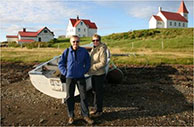Algeria – the North
Friday, 24 October 2025Algeria, it’s been on my ‘wish list,’ my ‘must do’ list for far too long and I finally got around to it. Two weeks in Algeria, a week in the North – big cities, the coast, Roman ruins – and then another week in the South – exploring the Sahara desert from Djanet, close to the corner where Algeria meets Libya and Niger.
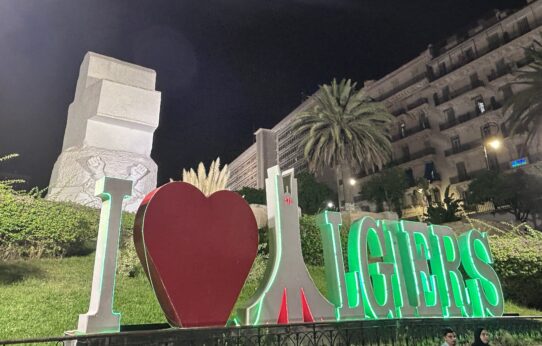 ▲I love Algiers – indeed why not
▲I love Algiers – indeed why not
People still think Algeria? Safety? But that’s old news, Algeria has changed enormously in the past 10 years and we never felt the least bit concerned during our travels. My biggest surprise struck me as soon as we left the airport and headed 20km west into Algiers the capital – everything was much more orderly, modern, even ‘affluent’ than I expected. The trip from the airport was closer to the glossy drive into Singapore from Changi Airport than the chaotic drive into New York City from JFK Airport.
 ▲ Algiers is the capital and a lot of the architecture in central Algiers is stunning. Yes, like Paris it’s down to Georges-Eugène Haussmann.
▲ Algiers is the capital and a lot of the architecture in central Algiers is stunning. Yes, like Paris it’s down to Georges-Eugène Haussmann.
Indeed the Algiers Casbah is chaotic and often terribly decayed. A New York Times article back in 2019 lamented that it was all falling apart, the population was declining and there was no popular support to do anything about it. Sadly not much has changed. Despite which it’s fascinating to explore and absolutely full of life.
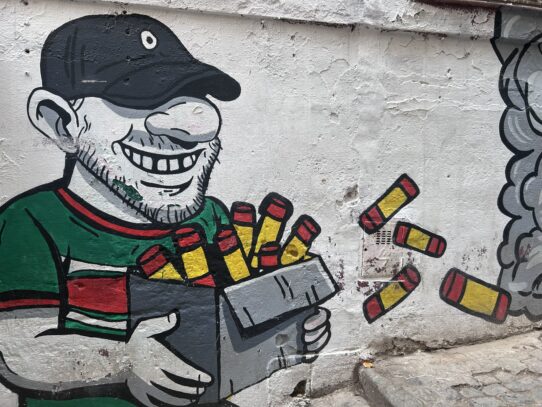 ▲ It’s also full of graffiti and street art including lots of work promoting the Ultras Green Corsairs, the Algiers football activists. This gentleman is spilling his box full of firecrackers as he heads to a game.
▲ It’s also full of graffiti and street art including lots of work promoting the Ultras Green Corsairs, the Algiers football activists. This gentleman is spilling his box full of firecrackers as he heads to a game.
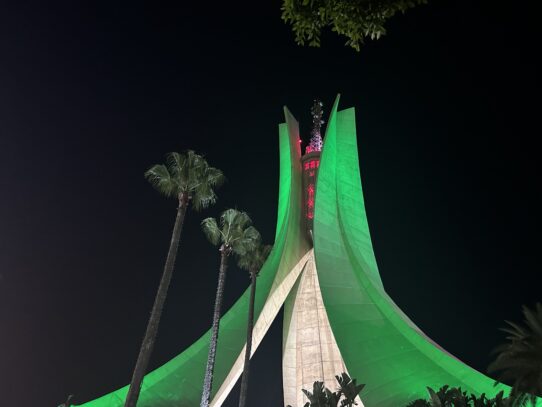 ▲ The Martyrs Memorial at Night
▲ The Martyrs Memorial at Night
Visible from all over Algiers the Martyrs Memorial looks terrific at night and the view from the outside is the best place to experience it. Inside there are assorted displays about how horrible the French were during the 1954 to 1962 Independence War. There are dioramas of assorted French massacres, all sorts of guns, pistols, knives, swords, bayonets, hand grenades and mines, much of it rusty and/or dusty. Plus a couple of guillotines and a torture chamber complete with activity and a moaning and screaming sound track. After 10 minutes of this I had more than absolutely enough and exited as quickly as I could. I know what a brutal story the war was, I didn’t need to have it forced down my throat. Incidentally the classic film The Battle of Algiers makes an appearance in the Paul Thomas Anderson film One Battle After Another.
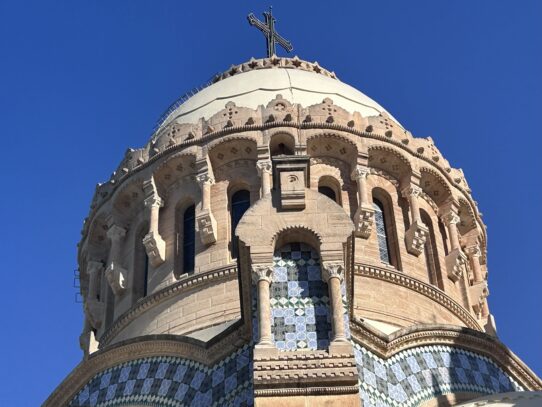
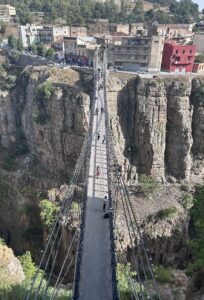 ▲ Notre Dame D’Afrique, Algiers – there’s also some interesting non-Haussmann architecture.
▲ Notre Dame D’Afrique, Algiers – there’s also some interesting non-Haussmann architecture.
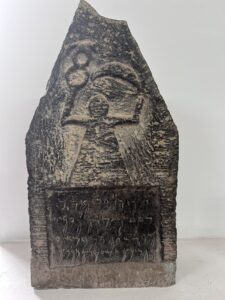 ◄ We travelled east from Algiers to Constantine, a city noted for the numerous bridges over the Rhumel Gorge which cuts through the city. The pedestrian-only Mellah Slimane Bridge seems to un-nerve people because it bounces, they should try a few suspension bridges in Nepal. We also drove across several of the bridges, but then crossed the narrow Sidi M’Cid Bridge on foot. For a spell after it opened in 1912 it was the highest bridge in the world. Above the bridge is the Monument aux Morts war memorial, modelled after the Roman Trajan Arch at Timgad which we visited the next day.
◄ We travelled east from Algiers to Constantine, a city noted for the numerous bridges over the Rhumel Gorge which cuts through the city. The pedestrian-only Mellah Slimane Bridge seems to un-nerve people because it bounces, they should try a few suspension bridges in Nepal. We also drove across several of the bridges, but then crossed the narrow Sidi M’Cid Bridge on foot. For a spell after it opened in 1912 it was the highest bridge in the world. Above the bridge is the Monument aux Morts war memorial, modelled after the Roman Trajan Arch at Timgad which we visited the next day.
◄ In the Museum Cirta I really like the Tanit Steles featuring a Cathaginian moon goddess involved with sacrifices. The museum featured a weird mix from Roman mosaics, juxtaposed with French colonial paintings, then some pre-history and some modern art (something a bit Dali-like).
Constantine also features the Musee Public National des Arts et Expressions Culturelles Traditionnelles which has lots of assorted craft stands and shops around the place, but is more important for being the Palais d’Ahmed Bey Constantine with assorted rooms, gardens and frescoes illustrating his voyage around the world.

◄ The Cardo Maximus, the main road through the Roman ruins of Timgad
Algeria is a positive reminder that the best Roman ruins are not in Italy – they’re often across the Mediterranean, particularly in Libya (Leptis Magna) and in Algerian sites like Timgad, directly south of Constantine. Timgad was also a reminder that at present – so go soon – Algeria is a long way from suffering from overtourism. There were perhaps 20 people on the extensive site, so our group of six English and Australia tourists, plus our Algerian guides, were a large slice of that day’s visitor total.
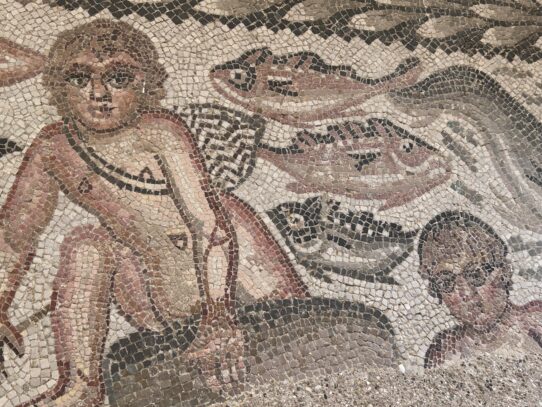
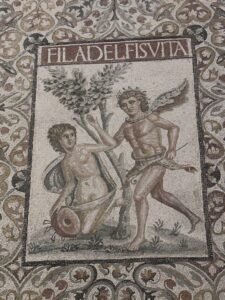 ▲ Boys fishing, a mosaic in the Timgad Museum – Algeria certainly has an amazing collection of Roman mosaics, like this one of boys catching fish. Are those swimming goggles he’s wearing?
▲ Boys fishing, a mosaic in the Timgad Museum – Algeria certainly has an amazing collection of Roman mosaics, like this one of boys catching fish. Are those swimming goggles he’s wearing?
◄ Filadelfis Vita, Jupiter chases Antiope, another mosaics in the Timgad Museum – I’m an enthusiast for mosaics, particularly Roman mosaics, anywhere. The town of Ravenna in Italy is worth visiting for its terrific early Christian mosaics alone. Or head to Gaziantep in Turkey, another reminder of how far Roman influence spread from the Mediterranean.
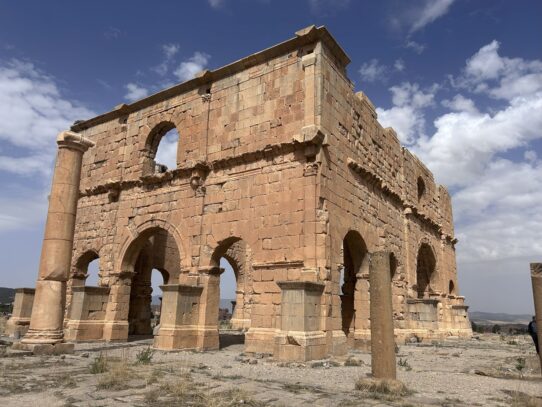 ▲ 3rd Legion Garrison Building in Lambaesis (Tazoult) – we also stopped at this smaller Roman site, not far from Timgad. The Garrison Building was certainly the main attraction, but the site also featured an excellent arch and the remains of the Roman Amphitheatre, plundered by the French to build their nearby jail.
▲ 3rd Legion Garrison Building in Lambaesis (Tazoult) – we also stopped at this smaller Roman site, not far from Timgad. The Garrison Building was certainly the main attraction, but the site also featured an excellent arch and the remains of the Roman Amphitheatre, plundered by the French to build their nearby jail.
 ▲ Travelling east back towards Algiers we overnighted in Setif where the Setif Archaeological Museum (The National Public Museum) has wonderful mosaics. Two of them on the floor as you enter the museum building are simply superb – the Dionysus Triumph and another dramatic Venus mosaic, flaunting her body as usual.
▲ Travelling east back towards Algiers we overnighted in Setif where the Setif Archaeological Museum (The National Public Museum) has wonderful mosaics. Two of them on the floor as you enter the museum building are simply superb – the Dionysus Triumph and another dramatic Venus mosaic, flaunting her body as usual.
 ▲ From Setif we backtracked to more superb Roman ruins at Jemila (Djemila), like the Severian Temple, perched up above the site’s excellent Roman Theatre.
▲ From Setif we backtracked to more superb Roman ruins at Jemila (Djemila), like the Severian Temple, perched up above the site’s excellent Roman Theatre.
Back in Algiers we made the short trip west to the coastal town of Cherchell where the modern city is built on top of the ancient Roman site, bits and pieces of ancient Rome pop up around the town.
 ◄ The Cherchell Museum is small, but packed with interesting pieces like this splendid sculpture of a cuirass – armoured breastplate – believed to be for the Emperor Claude.
◄ The Cherchell Museum is small, but packed with interesting pieces like this splendid sculpture of a cuirass – armoured breastplate – believed to be for the Emperor Claude.
Tipasa is another excellent Roman site, right on the coast only 26km east of Cherchell. There’s even a beach in amongst the ruins. It also features far more tourists than we have encountered at other Roman ruins in Algeria, although still a long way from overtouristed. The nice little theatre is smaller than others we’ve encountered and the amphitheatre is really minute.
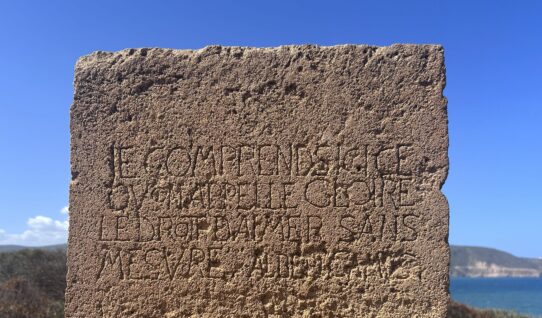 ▲ This Albert Camus inscription is from his essay Noces à Tipasa (Nuptials in Tipasa), on a stele just outside the Roman city limits at Tipasa.
▲ This Albert Camus inscription is from his essay Noces à Tipasa (Nuptials in Tipasa), on a stele just outside the Roman city limits at Tipasa.
• Je comprends ici ce qu’on appelle gloire: le droit d’aimer sans mesure.
• I understand here what is meant by glory: the right to love without limit.
 ▲ Not far from Tipasa is the mysterious site of the Mausoleum of Mauritania, a massive circular ‘tomb’ dating from perhaps the 4th century BC, so before the Romans arrived, but who for or why remains a mystery. It’s also known as the Christian Tomb and I was pleasantly surprised to realise I really knew nothing about it before I arrived at the site. It’s ‘associated with Cleopatra’s daughter, Cleopatra Selene II, and her husband, King Juba II and built with a mix of Berber, Egyptian, and Hellenistic styles’ I later read. A few days earlier, near Timgad so well to the east, we visited the slightly smaller Medracen Mausoleum, clearly out of the same historic architectural box, but with equally mysterious origins, although it is of a different, older Berber royal style.
▲ Not far from Tipasa is the mysterious site of the Mausoleum of Mauritania, a massive circular ‘tomb’ dating from perhaps the 4th century BC, so before the Romans arrived, but who for or why remains a mystery. It’s also known as the Christian Tomb and I was pleasantly surprised to realise I really knew nothing about it before I arrived at the site. It’s ‘associated with Cleopatra’s daughter, Cleopatra Selene II, and her husband, King Juba II and built with a mix of Berber, Egyptian, and Hellenistic styles’ I later read. A few days earlier, near Timgad so well to the east, we visited the slightly smaller Medracen Mausoleum, clearly out of the same historic architectural box, but with equally mysterious origins, although it is of a different, older Berber royal style.
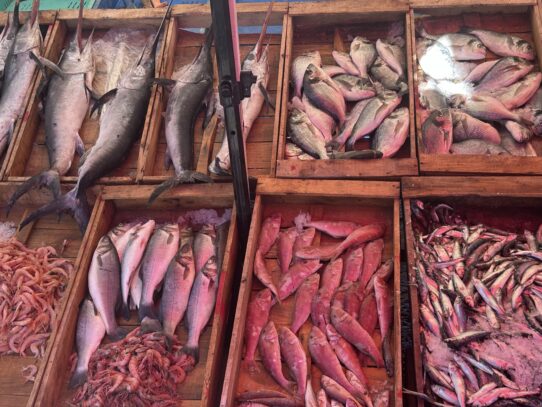 ▲ We certainly ate well in Algeria, particularly when it came to seafood. This market stall was right beside the seafood restaurant where we indulged after checking out the Roman ruins.
▲ We certainly ate well in Algeria, particularly when it came to seafood. This market stall was right beside the seafood restaurant where we indulged after checking out the Roman ruins.
 ▲ Further west the coastal city of Oran is another Algeria favourite with the Opera House overlooking the Place du 1er Noviembre and very modern trams that roll by. Constantine also has an ultra-modern tram service. Oran was the home for some years for Nobel Prize Winner Albert Camus. There’s nothing to see – apart from the address – of his Oran apartment at 67 Larbi-ben-M’hidi, it was rue d’Arzew in his day. You can, however, have a meal or a drink at Le Cintra, where Camus used to hang out during his Oran years.
▲ Further west the coastal city of Oran is another Algeria favourite with the Opera House overlooking the Place du 1er Noviembre and very modern trams that roll by. Constantine also has an ultra-modern tram service. Oran was the home for some years for Nobel Prize Winner Albert Camus. There’s nothing to see – apart from the address – of his Oran apartment at 67 Larbi-ben-M’hidi, it was rue d’Arzew in his day. You can, however, have a meal or a drink at Le Cintra, where Camus used to hang out during his Oran years.
Nearby is Disco Maghreb, shuttered today, but at one time a centre for Rai music. I’m reminded of the year I spent in Paris in the mid-90s when I’d often listen to Rai star Khaled suggesting to Aicha that she should ‘ecoutez moi’ – ‘listen to me.’
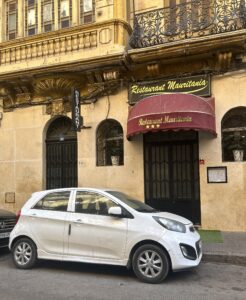
Oran was also the home of Yves Saint Laurent who lived here until he was 18, by which time he was already dreaming (check his illustrations) of becoming a fashion designer. The house is accurately, I imagine, furnished, but although his parents’ and sister’s bedrooms are there, his isn’t. I’m reminded of a 2012 visit to Marrakesh, where he was responsible for the beautiful Jardin Majorelle. The Saint Laurent house is very close to the externally rather attractive Ahmed Zabana National Public Museum, I’m not so blown away by the contents.
◄ We had an excellent lunch – seafood again – in Oran at the very atmospheric Restaurant Mauritania.
Everything worked so well in Algiers I was amazed there were not more tourists, but the Algerians are not exactly rolling out the red carpet for international visitors. Visas are awkward to get and expensive, even (slightly) more so if you opt for a visa on arrival, as I had to do. The cost seems to vary from week to week and also for how long you stayed and my visa started at €145, then seemed to have gone up to €185, but perhaps came down to €170 when I actually paid for it at the airport.
